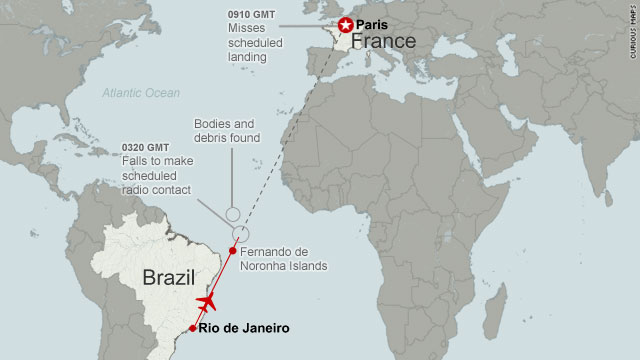75 additional bodies recovered from Air France crash after 2 years
May 31, 2011 11:42 a.m. EDT
STORY HIGHLIGHTS
- The remains have not been identified, a French relative says
- The recovery more than doubles the number of bodies found since the 2009 crash
- Air France 447 plunged into the ocean, killing 228 people
Paris Seventy-five additional bodies have been recovered from the wreckage of an Air France plane that crashed off the coast of Brazil two years ago, more than doubling the number of remains that have been found, the vice-president of the French victims' association told CNN Tuesday.The remains have not yet been identified, Robert Soulas said.
Air France 447 plunged into the Atlantic Ocean on June 1, 2009, killing all 228 people aboard. The bulk of the wreckage was found this year after a search by robot submarines of an underwater mountain range.
Many bodies were still in the fuselage, investigators said at the time. Only about 50 bodies were recovered in the days following the crash.
Soulas got the news from a French government liaison appointed to deal with families of victims, he said.
"Personally, I would have preferred to leave the bodies of our loved ones on the seafloor," he added, repeating his long-held view.





RELATED TOPICS
The Brazilian national news agency Agencia Brasil reported Tuesday that Nelson Faria Marinho, head of the Brazilian victims organization, said that with the latest recovery, the number of bodies found since the accident now totals 127.
Details of the doomed plane's last minutes only began to emerge last week as French air accident investigators studied data recorders recovered from the wreck earlier this year.
The Airbus A330 plummeted 38,000 feet in just three minutes and 30 seconds amid conflicting information that may have led the pilots to make bad decisions, France's Bureau of Investigation and Analysis (BEA) said Friday.
The pilots got conflicting air speed readings in the minutes leading up to the crash, according to an interim report. The aircraft climbed to 38,000 feet when "the stall warning was triggered and the airplane stalled," the report says.
Aviation experts are asking why the pilots responded to the stall by pulling the nose up instead of pushing it down to recover.
Miles O'Brien, a pilot and aviation analyst, said: "You push down on the wheel to gain air speed, perhaps they (pilots) were getting information that the air speed was too high. Pulling the nose up will exacerbate an aerodynamic stall."
The speeds displayed on the left primary flight display were "inconsistent" with those on the integrated standby instrument system (ISIS), the report says.
The aircraft experienced some "rolling" before stalling and then descending rapidly at 10,912 feet (3,300 meters) per minute.
At the time of the descent, the two co-pilots and captain were in the aircraft cockpit.
All 228 people aboard the Airbus A330 Flight 447 from Rio de Janeiro to Paris were killed on June 1, 2009.
The pilots lost contact with air traffic controllers while flying across an area of the Atlantic Ocean known for constant bands of severe turbulence.
Air crash investigators at the Paris-based BEA have been working on the theory that the speed sensors, known as pitot tubes or probes, malfunctioned because of ice at high altitude.
No comments:
Post a Comment